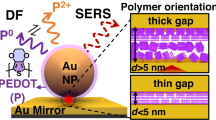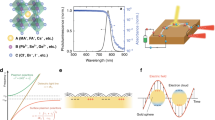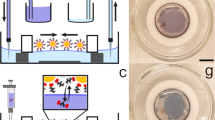Abstract
In traditional photoconductors1,2,3, the impinging light generates mobile charge carriers in the valence and/or conduction bands, causing the material’s conductivity to increase4. Such positive photoconductance is observed in both bulk and nanostructured5,6 photoconductors. Here we describe a class of nanoparticle-based materials whose conductivity can either increase or decrease on irradiation with visible light of wavelengths close to the particles’ surface plasmon resonance. The remarkable feature of these plasmonic materials is that the sign of the conductivity change and the nature of the electron transport between the nanoparticles depend on the molecules comprising the self-assembled monolayers (SAMs)7,8 stabilizing the nanoparticles. For SAMs made of electrically neutral (polar and non-polar) molecules, conductivity increases on irradiation. If, however, the SAMs contain electrically charged (either negatively or positively) groups, conductivity decreases. The optical and electrical characteristics of these previously undescribed inverse photoconductors can be engineered flexibly by adjusting the material properties of the nanoparticles and of the coating SAMs. In particular, in films comprising mixtures of different nanoparticles or nanoparticles coated with mixed SAMs, the overall photoconductance is a weighted average of the changes induced by the individual components. These and other observations can be rationalized in terms of light-induced creation of mobile charge carriers whose transport through the charged SAMs is inhibited by carrier trapping in transient polaron-like states9,10. The nanoparticle-based photoconductors we describe could have uses in chemical sensors and/or in conjunction with flexible substrates.
This is a preview of subscription content, access via your institution
Access options
Subscribe to this journal
Receive 51 print issues and online access
$199.00 per year
only $3.90 per issue
Buy this article
- Purchase on Springer Link
- Instant access to full article PDF
Prices may be subject to local taxes which are calculated during checkout





Similar content being viewed by others
References
Adam, D. et al. Fast photoconduction in the highly ordered columnar phase of discotic liquid-crystal. Nature 371, 141–143 (1994)
Sze, S. M. Physics of Semiconductor Devices (Wiley & Sons, 1981)
Yu, G., Gao, J., Hummelen, J. C., Wudl, F. & Heeger, A. J. Polymer photovoltaic cells — enhanced efficiencies via a network of internal donor-acceptor heterojunctions. Science 270, 1789–1791 (1995)
Joshi, N. V. Photoconductivity: Art, Science and Technology (Marcel Dekker, 1990)
Han, S. et al. Photoconduction studies on GaN nanowire transistors under UV and polarized UV illumination. Chem. Phys. Lett. 389, 176–180 (2004)
Hayden, O., Agarwal, R. & Lieber, C. M. Nanoscale avalanche photodiodes for highly sensitive and spatially resolved photon detection. Nature Mater. 5, 352–356 (2006)
Love, J. C., Estroff, L. A., Kriebel, J. K., Nuzzo, R. G. & Whitesides, G. M. Self-assembled monolayers of thiolates on metals as a form of nanotechnology. Chem. Rev. 105, 1103–1169 (2005)
Witt, D., Klajn, R., Barski, P. & Grzybowski, B. A. Applications properties and synthesis of omega-functionalized n-alkanethiols and disulfides — the building blocks of self-assembled monolayers. Curr. Org. Chem. 8, 1763–1797 (2004)
Galperin, M., Ratner, M. A. & Nitzan, A. Hysteresis, switching, and negative differential resistance in molecular junctions: a polaron model. Nano Lett. 5, 125–130 (2005)
Kuznetsov, A. M. Negative differential resistance and switching behavior of redox-mediated tunnel contact. J. Chem. Phys. 127, 084710 (2007)
Kalsin, A. M. et al. Electrostatic self-assembly of binary nanoparticle crystals with a diamond-like lattice. Science 312, 420–424 (2006)
Kalsin, A. M., Kowalczyk, B., Smoukov, S. K., Klajn, R. & Grzybowski, B. A. Ionic-like behavior of oppositely charged nanoparticles. J. Am. Chem. Soc. 128, 15046–15047 (2006)
Kalsin, A. M. et al. Electrostatic aggregation and formation of core-shell suprastructures in binary mixtures of charged metal nanoparticles. Nano Lett. 6, 1896–1903 (2006)
Pinchuk, A. O., Kalsin, A. M., Kowalczyk, B., Schatz, G. C. & Grzybowski, B. A. Modeling of electrodynamic interactions between metal nanoparticles aggregated by electrostatic interactions into closely-packed clusters. J. Phys. Chem. C 111, 11816–11822 (2007)
Engelkes, V. B., Beebe, J. M. & Frisbie, C. D. Length-dependent transport in molecular junctions based on SAMs of alkanethiols and alkanedithiols: effect of metal work function and applied bias on tunneling efficiency and contact resistance. J. Am. Chem. Soc. 126, 14287–14296 (2004)
Bozano, L. D. et al. Organic materials and thin-film structures for cross-point memory cells based on trapping in metallic nanoparticles. Adv. Funct. Mater. 15, 1933–1939 (2005)
Lee, J. S. et al. Layer-by-layer assembled charge-trap memory devices with adjustable electronic properties. Nature Nanotechnol. 2, 790–795 (2007)
Lampert, M. A. Simplified theory of space-charge-limited currents in an insulator with traps. Phys. Rev. 103, 1648–1656 (1956)
Many, A. & Rakavy, G. Theory of transient space-charge-limited currents in solids in presence of trapping. Phys. Rev. 126, 1980–1988 (1962)
Lee, T. et al. Comparison of electronic transport characterization methods for alkanethiol self-assembled monolayers. J. Phys. Chem. B 108, 8742–8750 (2004)
Nitzan, A. Chemical Dynamics in Condensed Phases (Oxford Univ. Press, 2006)
Willets, K. A. & Van Duyne, R. P. Localized surface plasmon resonance spectroscopy and sensing. Annu. Rev. Phys. Chem. 58, 267–297 (2007)
Zou, S. L. & Schatz, G. C. in Surface-Enhanced Raman Scattering: Physics and Applications (eds Kneipp, K., Moskovits, M. & Kneipp, H.) 67–85 (Topics in Applied Physics, Vol. 103, Springer, 2006)
Kalsin, A. M., Kowalczyk, B., Wesson, P., Paszewski, M. & Grzybowski, B. A. Studying the thermodynamics of surface reactions on nanoparticles by electrostatic titrations. J. Am. Chem. Soc. 129, 6664–6665 (2007)
Novembre, C., Guerin, D., Lmimouni, K., Gamrat, C. & Vuillaume, D. Gold nanoparticle-pentacene memory transistors. Appl. Phys. Lett. 92, 103314 (2008)
Weiss, E. A. et al. Conformationally gated switching between superexchange and hopping within oligo-p-phenylene-based molecular wires. J. Am. Chem. Soc. 127, 11842–11850 (2005)
Jortner, J. & Noyes, R. M. Some thermodynamic properties of the hydrated electron. J. Phys. Chem. 70, 770–774 (1966)
Schnitker, J. & Rossky, P. J. Quantum simulation study of the hydrated electron. J. Chem. Phys. 86, 3471–3485 (1987)
Zhan, C. G. & Dixon, D. A. The nature and absolute hydration free energy of the solvated electron in water. J. Phys. Chem. B 107, 4403–4417 (2003)
Nguyen, T. D. et al. A reversible molecular valve. Proc. Natl Acad. Sci. USA 102, 10029–10034 (2005)
Acknowledgements
We thank M. Ratner, G. C. Schatz and R. van Duyne for discussions and advice. This work was supported by the Alfred P. Sloan Fellowship and the Dreyfus Teacher-Scholar Award (to B.A.G.).
Author Contributions H.N. performed the experiments, and collected and analysed the data; K.J.M.B., A.N., E.A.W. and B.A.G. developed the theoretical model; B.K. and R.K. synthesized nanoparticles and thiols; K.V.T. and M.M.A. helped with the construction of the Faraday cage and with data analysis; J.F.S. planned synthesis and helped with the interpretation of results; and B.A.G. conceived the experiments, analysed results, and wrote the paper.
Author information
Authors and Affiliations
Corresponding author
Supplementary information
Supplementary Information
This file contains Supplementary Notes (incorporating Figures S1-S7): (1) Further experimental details, (2) Discussion of the origins of negative activation energy, (3) Transport model of photoconductance in NP arrays, (4) Further comments regarding plasmonic effects; and Supplementary References. (PDF 1070 kb)
Rights and permissions
About this article
Cite this article
Nakanishi, H., Bishop, K., Kowalczyk, B. et al. Photoconductance and inverse photoconductance in films of functionalized metal nanoparticles. Nature 460, 371–375 (2009). https://doi.org/10.1038/nature08131
Received:
Accepted:
Issue Date:
DOI: https://doi.org/10.1038/nature08131
This article is cited by
-
Large emergent optoelectronic enhancement in molecularly cross-linked gold nanoparticle nanosheets
Communications Chemistry (2022)
-
Polarization-sensitive optoionic membranes from chiral plasmonic nanoparticles
Nature Nanotechnology (2022)
-
Design of non-autonomous pH oscillators and the existence of chemical beat phenomenon in a neutralization reaction
Scientific Reports (2021)
-
Positive and Negative Photoconductivity Conversion Induced by H2O Molecule Adsorption in WO3 Nanowire
Nanoscale Research Letters (2019)
-
Humidity sensor and ultraviolet photodetector based on carrier trapping effect and negative photoconductivity in graphene quantum dots
Science China Physics, Mechanics & Astronomy (2018)
Comments
By submitting a comment you agree to abide by our Terms and Community Guidelines. If you find something abusive or that does not comply with our terms or guidelines please flag it as inappropriate.



